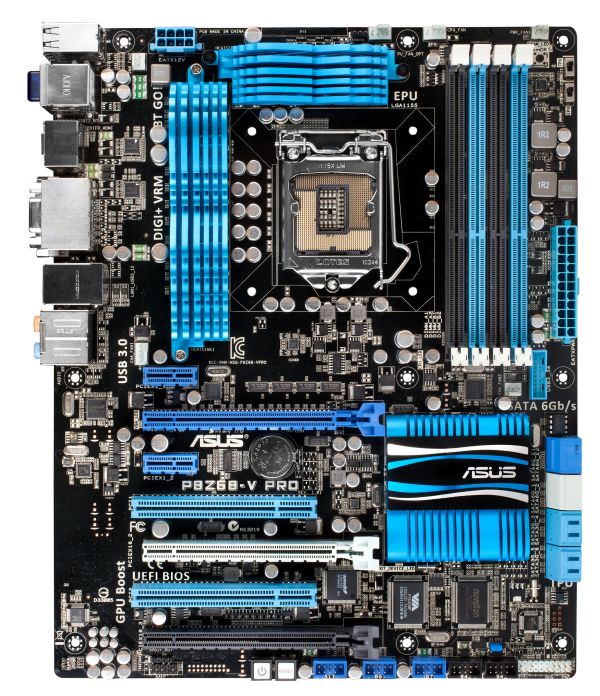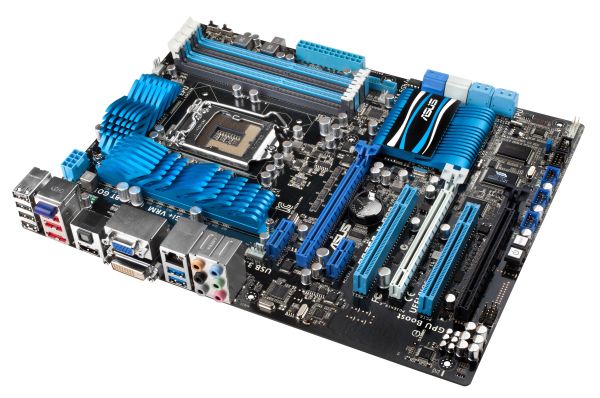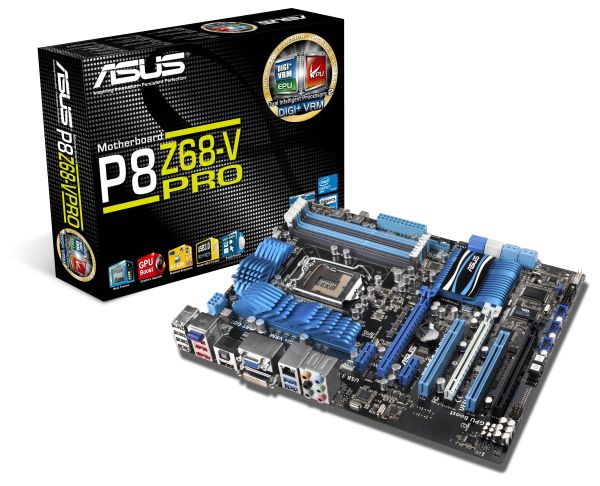ASUS P8Z68-V PRO Review: Our First Z68 Motherboard
by Ian Cutress on May 11, 2011 3:13 AM EST- Posted in
- Motherboards
- Asus
- Z68
ASUS P8Z68-V PRO: Overview
This board from ASUS is a great all-round performer, compared to the P67 boards we have reviewed—space for tri-GPU setups, six fan headers with good OS fan controls, eight SATA ports, six with RAID 0/1/5/10, Intel gigabit Ethernet and it performs well in our benchmark suite. The goods bundled in the box aren't the best we've seen, especially for an expected retail price of $210. But this is a Z68 board—the seemingly logical progression Intel have taken to combine the best bits of P67 and H67, in terms of overclocking. It's thanks to software solutions such as LUCIDLOGIX's Virtu that we can harness both the integrated GPU and discrete GPUs for different work loads—I detail my experiences with Virtu in this review.
ASUS P8Z68-V PRO: Visual Inspection
A quick look at the P8Z67-V PRO board and you might be joining me in thinking it looks almost identical to the P8P67 PRO motherboard. The blue, black and grey livery is still here, with those blue wavy heatsinks covering up the 12 phase CPU and 4 phase iGPU power delivery—unlike other boards, these aren't joined by a heatpipe, and the larger heatsink has a pretty substantial plate connecting the ends on the back of the board.
Around the socket itself, there is one 4-pin chassis fan header near the PCIe 1x, one PWR 3-pin near the 12V CPU power connector, and two CPU fan headers (one 4-pin, one 3-pin) to the top right, which should cover any all-in-one cooling solution with a dual fan and water pump arrangement. Unlike some other Cougar Point motherboards, ASUS have located the PCH to below the DIMM slots, under a large flat heatsink which gets quite warm to touch under normal operation.
Alongside the DIMM slots we have another 3-pin PWR fan header in the top right, just above ASUS' EPU and TPU switches, which activate their Energy Processing Unit and TurboV Processing Units respectively, for lower power usage or automatic overclocking. Enabling both could lead to system instability, however. Underneath these, beyond the 24-pin ATX power connector is a a 3-pin chassis fan header and the USB 3.0 19-pin header. As this is placed here, you would assume ASUS are thinking everyone will be using this header to power a USB 3.0 bracket in the front of the case, rather than the rear. But the supplied USB 3.0 bracket is designed for the rear of the board and doesn't stretch that far, especially over a dual slot GPU should one be in use.
The SATA ports are similar to that found on the P8P67 Pro—the four SATA 3 Gbps from the PCH are in blue, the two SATA 6 Gbps from the PCH are in white, and two SATA 6 Gbps from a Marvell controller. Rather than place the Power/Reset buttons underneath the SATA ports, they are found amongst the myriad of USB and IEEE 1394 headers along the bottom of the board, making them very inconvenient if all three full-size PCIe slots are occupied with dual slot cards.
The PCIe slot arrangement is standard—enough space at the top for a full length PCIe x1 card, with a PCIe x16 slot underneath with a triple slot gap to the next PCIe x16. The three full length PCIe slots run in x16/x0/x4 or x8/x8/x4 mode for GPU setups. However, the bottom PCIe slot shares bandwidth PCIe x1 slots, a two USB ports in the IO panel and the eSATA IO port—all of these are inactive if the bottom PCIe is in x4 mode. By default, the PCIe is in x1 mode, and requires a BIOS setting change for x4.
The IO panel for Z68 boards supporting integrated graphics is a combined mix of previous P67 and H67 iterations, and as such we either lose legacy connections or USB ports infavor of video out ports. There's no PS/2 legacy connector—instead we have on the far left four USB 2.0 ports, then another two USB 2.0 ports, the eSATA 3 Gbps port powered by a JMicron JMB362 controller, and a Bluetooth module. These red USB 2.0 ports/eSATA port are the ones disabled when the third PCIe is in x4 mode. In terms of video outputs, we have a HDMI, DVI and VGA—no display port here, instead you get an optical S/PDIF out (which also means no coaxial S/PDIF out). Just a single gigabit Ethernet port powered by an Intel 82579, and a pair of USB 3.0 ports powered by ASMedia controller. Standard Realtek ALC892 8-channel audio is also present.














95 Comments
View All Comments
AnnihilatorX - Wednesday, May 11, 2011 - link
Short answer, no...mczak - Wednesday, May 11, 2011 - link
IMHO doesn't make a whole lot of sense overclocking the IGP but not the memory. The IGP could potentially benefit quite a bit.Markstar - Wednesday, May 11, 2011 - link
Great review - makes me wish Anandtech had more of these (along with reviews low-capacity SSDs). :pShadowmaster625 - Wednesday, May 11, 2011 - link
You guys need to stop giving Asus a free pass on their horrible website that you cant even download drivers from. And their horrible bios flashing tools that do not work. Never ever buy asus.sor - Wednesday, May 11, 2011 - link
I'm actually kind of pissed at them myself. my P8P67Pro is a good board, but it has problems with SAS cards. They updated the BIOS to fix some compatibility issues, but my LSI card still does not work. It's a pretty well documented issue, and I think it's sort of ridiculous. I will consider buying a new Z68 of a different brand so I can use my LSI card if they don't have a BIOS fix soon.I didn't have any trouble flashing to the latest ASUS BIOS with a DOS boot cd.
The_Assimilator - Wednesday, May 11, 2011 - link
You're using a piece of server hardware in a desktop board and you don't understand why it doesn't work? Did you perhaps think about that, or about verifying compatibility between the board and the card before purchasing?Don't blame the manufacturer for your own ignorance.
sor - Wednesday, May 11, 2011 - link
Give me a break. That's the most ridiculous comment I've heard in a long while. You're the one showing your ignorance now.sor - Wednesday, May 11, 2011 - link
Sorry, I can't let this go. I'm not sure why you decided to take an antagonstic tone, but apparently hardware is mysterious to you? What makes you think this is a server part? What makes you think it's unreasonable to believe that a card that adheres to the PCIe standard should be able to work in a PCIe slot? Why is it unreasonable to think that a card that worked in an old P35 desktop and my wife's older Q965 should work in my new P67 desktop? I can only imagine you read "SAS" and thought "ooh scary, that's the shiny server stuff, what is this guy thinking? I need to belittle him". Nevermind that they make windows XP drivers for it. Nevermind that I've installed over 300 LSI SAS cards in various hardware over the last year at work.Compatibility lists are not exhaustive, and are usually 6-12 months out of date. I still maintain that it's a reasonable expectation that a PCIe card shipping with desktop OS drivers, that works in every other motherboard I can get a hold of, should work in the PCIe slot of my new motherboard, and if not, it's the motherboard's fault.
L. - Thursday, May 12, 2011 - link
I would say, let's blame the manufacturers ... So many inconsistencies should not be tolerated, like for example some sticks not working on some boards etc.. or ridiculous PCB design leading to not being able to put a 'standard' modern cooler / ridiculous cooler design the other way around etc. etc.Pneumothorax - Wednesday, May 11, 2011 - link
Does overclocking the IGP help Quicksync speeds? I don't think I've seen testing done on this so far.